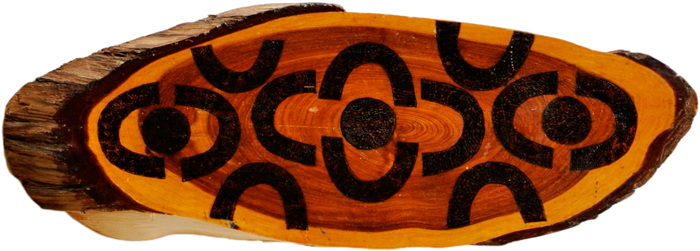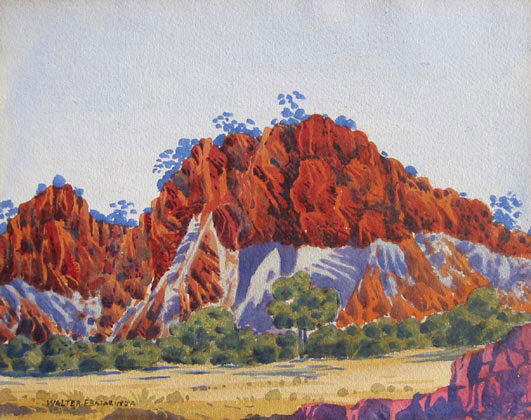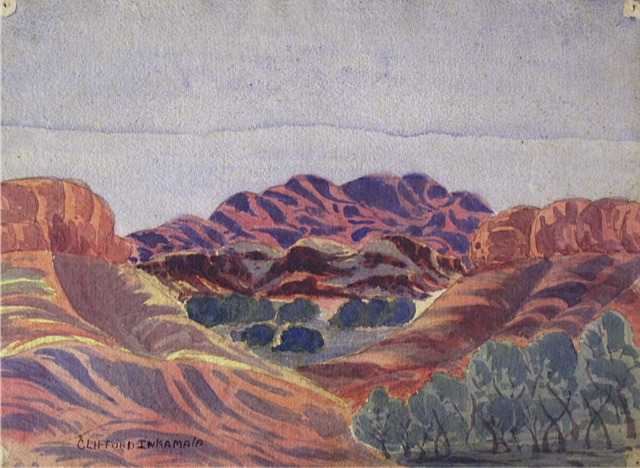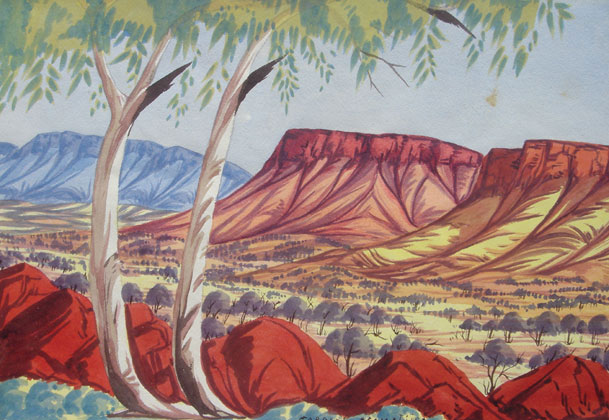Artists
The first 10 artists featured in
Modern Aboriginal Art
by Rex Battarbee, 1951

Albert Namatjira (1902-1959)
Albert became interested in watercolour painting after seeing an impromptu art exhibition at Hermannsburg in 1934 featuring the works of traveling artists Rex Battarbee and John Gardner. The paintings amazed Albert who immediately asked Pastor Albrecht if he too could paint. Albrecht initially dismissed his enquiry but Albert persisted and Albrecht then consulted with Battarbee who offered to give him lessons. In 1936 Battarbee returned and commissioned Albert as his camel boy to take him on a painting trip. Albert guided Battarbee through some of the most spectacular country in Central Australia, including Palm Valley, The James Range and Gosses Gorge and in return received his long awaited lessons. His first paintings were signed simply Albert. It was not until he started exhibiting that it was thought necessary for him to have a second name. He chose his fathers traditional name and signed his works, Albert Namatjira.
His first major public exhibition was opened in Melbourne on the 5th of December 1938, all 41 works sold within days. During the second world war Albert sold his paintings to Australian and American soldiers based in Alice Springs. A shortage of materials forced him to substitute paper for local beanwood which he crafted into smooth wooden plaques. Alberts reputation grew after the war and exhibitions of his work were held across Australia. In his lifetime he met with dignitaries from around the world, including the Queen of England but despite his fame he longed for the peaceful surroundings of his homelands. His paintings divided critics but today hang in all state galleries including the National gallery of Australia which has a collection of Hermannsburg art on permanent display in its Indigenous art wing.
Language Group: Western Arrernte
Skin: Kngwarreye
Tribal Name: Tonanga

Edwin Pareroultja (1918-1986)
He began painting in 1943. His first attempt at painting astounded Rex Battarbee who encouraged him to develop his own style. “The greatest impression any artist has ever made on me was on 25th October 1943, when Edwin showed me his first watercolour, Rex Battarbee, Modern Australian Aboriginal Art, 1951”. His first solo exhibition was held in 1946 at the Athenaeum Art Gallery in Melbourne. Early works 1943/44 were signed, Edwin ‘B’areroultja.
Language Group: Western Arrernte
Skin: Kngwarreye

Otto Pareroultja (1914-1973)
Language Group: Western Arrernte
Skin: Kngwarreye

Reuben Pareroultja (1916-1986)
Language Group: Western Arrernte
Skin: Kngwarreye

Walter Ebatarinja (1915-1968)
Language Group: Western Arrernte

Enos Namatjira (1920-1966)
Language Group: Western Arrernte
Skin: Peltharre

Oscar Namatjira (1922-1991)
Language Group: Western Arrernte
Skin: Peltharre

Henoch Raberaba (1914-1975)
Language Group: Western Arrernte
Skin: Kngwarreye or Penangke
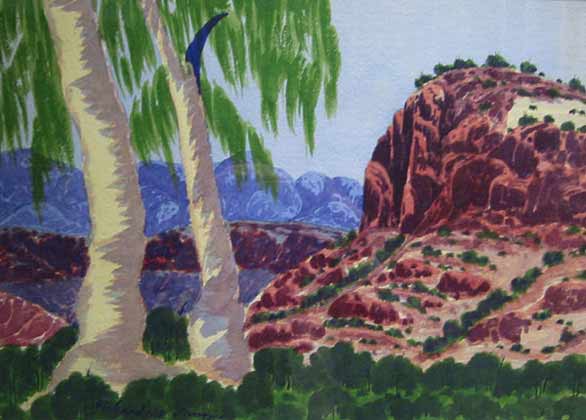
Richard Moketarinja (1916-1983)
Language Group: Western Arrernte
Skin: Peltharre

Ewald Namatjira (1930-1984)
Language Group: Western Arrernte
Skin: Peltharre
Directory of other artists
Clem Abbott (1939-1989)
Douglas Abbott (1948
Arnulf Ebatarinja (1931-)
Cordula Ebatarinja (1919-1973)
Language Group: Western Arrernte
Skin: Peltharre
Desmond Ebatarinja (1946-2004)
Kenneth Entata (1932-1982)
Richard Forrester (1938-)
Adolf Inkamala (1914-1960)
Language Group: Western Arrernte
Skin: Mpetyane
Gerhard Inkamala (1917-1977)
Lindburg Inkamala (1942-1980)
Johannes Katakarinja (1956-)
Benjamin Landara (1921-1985)
Language Group: Western Arrernte
Skin: Kemarre
John Landara (1953-)
Harold Lankin (1934-)
Gustav Malbunka (1909-1989)
Language Group: Western Arrernte
Skin: Peltharre
Melvin Malbunka (1940-)
Harold Malthouse (1952-1989)
Gloria Moketarinja (1922-1982)
Richard Moketarinja (1918-1983)
Allan Namatjira (1954-)
Gabriel Namatjira (1942-1969)
Herman Namatjira (1952-1979)
Keith Namatjira (1938-1977)
Language Group: Western Arrernte
Skin: Peltharre
Maurice Namatjira (1939-1977)
Reggie Namatjira (1946-)
Claude Pannka (1927-1972)
Gloria Pannka (1953-)
Language Group: Luritja
Skin: Perrurle
The Pareroultja Brothers
“There are several major native-cat totemic sites to be found in the Mt. Sonder area, but all of these are located in rugged country several miles distant from the mountain. One of them is PaEroultja… once the home of the long deceased father of three well-known Hermannsburg watercolour artists originally christened Ruben, Otto and Edwin; they later adopted the name of their fathers totemic site as their own family name”. STREHLOW – Mythology of the Centralian Aboriginie.






